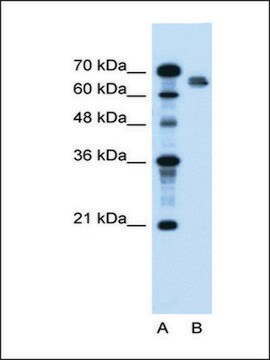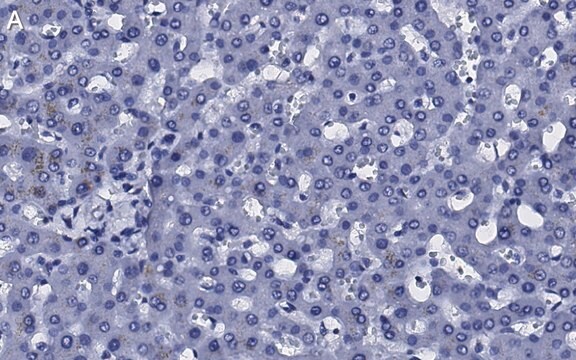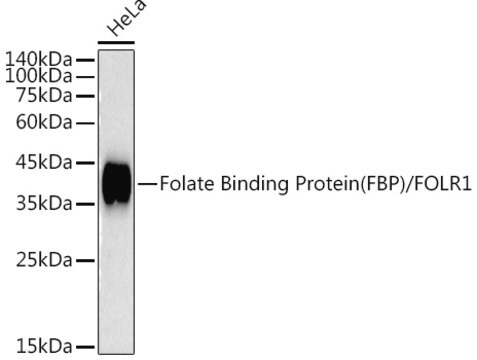추천 제품
생물학적 소스
rabbit
Quality Level
결합
unconjugated
항체 형태
affinity isolated antibody
항체 생산 유형
primary antibodies
클론
polyclonal
양식
buffered aqueous solution
분자량
133 kDa
종 반응성
mouse, human, rabbit, rat
농도
0.5 mg - 1 mg/mL
기술
western blot: suitable
NCBI 수납 번호
UniProt 수납 번호
배송 상태
wet ice
저장 온도
−20°C
타겟 번역 후 변형
unmodified
유전자 정보
human ... ERCC5(2073)
면역원
Synthetic peptide directed towards the N terminal region of human ERCC5
애플리케이션
Anti-ERCC5 antibody produced in rabbit is suitable for western blotting at a concentration of 1μg/mL
생화학적/생리학적 작용
Excision repair cross-complementing rodent repair deficiency, complementation group 5 (xeroderma pigmentosum, complementation group G) is involved in excision repair of UV-induced DNA damage. Mutations cause Cockayne syndrome, which is characterized by severe growth defects, mental retardation, and cachexia. Excision repair cross-complementing rodent repair deficiency, complementation group 5 (xeroderma pigmentosum, complementation group G) is involved in excision repair of UV-induced DNA damage. Mutations cause Cockayne syndrome, which is characterized by severe growth defects, mental retardation, and cachexia. Multiple alternatively spliced transcript variants encoding distinct isoforms have been described, but the biological validity of all variants has not been determined. Publication Note: This RefSeq record includes a subset of the publications that are available for this gene. Please see the Entrez Gene record to access additional publications.
서열
Synthetic peptide located within the following region: NPQAIDIESEDFSSLPPEVKHEILTDMKEFTKRRRTLFEAMPEESDDFSQ
물리적 형태
Purified antibody supplied in 1x PBS buffer with 0.09% (w/v) sodium azide and 2% sucrose.
면책조항
Unless otherwise stated in our catalog or other company documentation accompanying the product(s), our products are intended for research use only and are not to be used for any other purpose, which includes but is not limited to, unauthorized commercial uses, in vitro diagnostic uses, ex vivo or in vivo therapeutic uses or any type of consumption or application to humans or animals.
적합한 제품을 찾을 수 없으신가요?
당사의 제품 선택기 도구.을(를) 시도해 보세요.
Storage Class Code
10 - Combustible liquids
WGK
WGK 3
Flash Point (°F)
Not applicable
Flash Point (°C)
Not applicable
가장 최신 버전 중 하나를 선택하세요:
The human gene for xeroderma pigmentosum complementation group G (XPG) maps to 13q33 by fluorescence in situ hybridization.
S Samec et al.
Genomics, 21(1), 283-285 (1994-05-01)
A O'Donovan et al.
Nature, 371(6496), 432-435 (1994-09-29)
Humans with a defect in the XPG protein suffer from xeroderma pigmentosum (XP) resulting from an inability to perform DNA nucleotide excision repair properly. Here we show that XPG makes a structure-specific endonucleolytic incision in a synthetic DNA substrate containing
J E Cleaver et al.
Human mutation, 14(1), 9-22 (1999-08-14)
The human diseases xeroderma pigmentosum, Cockayne syndrome, and trichothiodystrophy are caused by mutations in a set of interacting gene products, which carry out the process of nucleotide excision repair. The majority of the genes have now been cloned and many
S G Clarkson
Biochimie, 85(11), 1113-1121 (2004-01-17)
I provide a personal account of the discovery, cloning and functional analyses of the human XPG gene. Mutations in this gene can give rise to the group G form of xeroderma pigmentosum (XP) and, in some cases, to severe early
M A MacInnes et al.
Molecular and cellular biology, 13(10), 6393-6402 (1993-10-01)
Several human genes related to DNA excision repair (ER) have been isolated via ER cross-species complementation (ERCC) of UV-sensitive CHO cells. We have now isolated and characterized cDNAs for the human ERCC5 gene that complement CHO UV135 cells. The ERCC5
자사의 과학자팀은 생명 과학, 재료 과학, 화학 합성, 크로마토그래피, 분석 및 기타 많은 영역을 포함한 모든 과학 분야에 경험이 있습니다..
고객지원팀으로 연락바랍니다.








